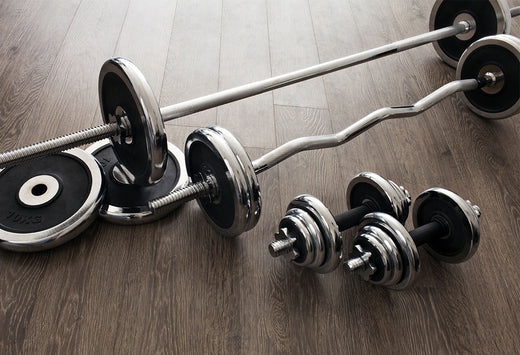You step into the weight room. You look to your left and you see several barbells and accompanying weight plates. You look to your right and you see a row of dumbbells, ranging from 5 to 125 pounds. Which side do you start walking towards?
Dumbbells and barbells are foundational fitness equipment. There's no denying that both are important for a well-rounded fitness program. But let's say you had to choose just one to use for the rest of your life. Which one would you choose?
If you're like most people, it's tough to get off the fence and pick a side. We want to have some fun with this and settle the debate once and for all. Let's look at the benefits and downsides of using dumbbells vs. barbells to determine which is best for achieving your fitness goals.
WHAT IS A DUMBBELL?
It's more than a nickname for your best friend. A
dumbbell is a fitness tool that is used in resistance training. A dumbbell is a short, weighted bar or handle with enough space for your hand to grip it. On each end of the bar, you'll find a weight. Depending on your dumbbell type, the weight will be fixed or adjustable. If you have an adjustable dumbbell, you'll find that just outside your hand, a raised piece stops weight plates from moving. On either side of the handle, you can place one or several weight plates and then secure them in place with a screw.
BENEFITS OF DUMBBELLS
What's so special about dumbbells that they've been around for decades?
Easy on the Joints
Dumbbells are great for those who have issues with prior surgeries or injuries. Since they allow for more natural movement patterns and full range of motion, dumbbells are going to be easier on your joints during exercise.
Prevents Overcompensation
When a strong muscle takes over for a nearby weak muscle, this is called overcompensation. Over time, this can burn out the strong muscle and increase your risk for injury. Dumbbells force you to train in a unilateral way, which means each side of the body must do the work. A stronger side – like your right side, for example – can't pick up the extra slack. While it might mean that you have to use a lighter weight, it also means that you'll be building strength and muscle mass equally.
Muscle Activation
Studies show that dumbbells increase muscle activation more than barbells during certain exercises. For example, dumbbells activate the biceps brachii more during a chest press than a barbell. [1]
Convenience and Cost
Dumbbells are one of the most convenient pieces of weightlifting equipment you can buy. Outside of the obvious restriction of heavier weights, you can bring your dumbbells to exercise outside, in a park, or while traveling.
They are also great for when you want to build a home gym. Even a simple set of dumbbells ranging from 5 to 25 pounds will be enough for most people and save you a ton of money on expensive gym memberships.
Overall Safety
In general, dumbbells are going to be a safer option.
This is because you can adjust the weight easier, and if things get too heavy, you can toss them on the side. If you have a workout buddy, they will find that dumbbells tend to be easier to spot when compared to a barbell.
WHAT IS A BARBELL?
You can think of a barbell as an oversized dumbbell. A long stretch of steel with knurled marks provides various places for hand grip. Like an adjustable dumbbell, you will add or remove weight plates according to your ability, exercise, and preference. These plates are kept in place by a clip or fastener. A weightlifting barbell is not the same as an Olympic barbell. The former can vary in size, weight, and the type of external weight plates you can use. An Olympic barbell, on the other hand, is always regulating size and weight. They are seven feet long and weigh 45 pounds (20 kilograms). This is the type of barbell you'll find in most commercial gyms. Unlike dumbbells that can be placed or stacked on the ground, a barbell is going to require a rack for both proper storage and exercise performance. A squat rack is an ideal beginner-friendly way to store your barbell and perform various foundational exercises like the squat and bench press.
BENEFITS OF BARBELLS
Here are some reasons a barbell would be an excellent choice during your workouts.
Maximum Weight
When it comes to all-out weight, barbells are what you need. Olympic barbells have a weight limit of 500 pounds. Sure, you might only stack on a little, but it's nice knowing you could.
Setting New 1RMs
Continuing with the point above, given the high weight limit of a barbell, they will be a fantastic tool for setting new one-repetition maximums. This goes double for those who are interested in powerlifting or Strongman lifting. Powerlifting focuses on three exercises: the squat, deadlift, and bench press. What's more, you're trying to set a new PR weekly. The barbell is ideal for this type of athlete.
Explosiveness
Explosive lifting is a must if you want to improve raw power, acceleration, and speed. Olympic barbells are made specifically for this type of lifting so it's no surprise that power-driven sports like CrossFit rely so heavily on them. Here's the breakdown of this:
When you see a barbell, you're looking at two separate pieces. There is the shaft, and there is the bar. Barbells are designed so that the end can spin during movements like the clean and jerk or the snatch.
ARE DUMBBELLS BETTER THAN BARBELLS?
The short answer is: It depends.
Are you new to fitness? Are you recovering from surgery? Do you want to build a foundation of fitness? Then dumbbells will be better for you.
Have you been lifting for a long time? Are you a powerlifter? Looking to focus on building raw power and strength? You might prefer barbells.
With that said, let's talk about why dumbbells are better than barbells. We're basing this on the fact that more people are new to fitness or not confident in their workouts.
They Are More Convenient
For what barbells offer in terms of total weight and durability, they lack in convenience. If you're using a barbell, you're limited to that location only. Unless you want to try to fit a 45-pound dumbbell in a car every time you travel somewhere.
Dumbbells, however, can be transported to different workout locations within reason. It'll be a task to travel with 150-pound dumbbells, for example, but chances are you wouldn't be doing that anyway.
Overcompensation Isn't an Issue
Since you're training in a unilateral (one side at a time) fashion, you don't have to worry about one part of the body picking up the slack for a weaker part.
With barbells, this isn't the case.
If your right side is noticeably weaker than your left, the latter will take on more effort and weight. This is especially true if your form is also incorrect.
Best Way to Build a Fit Foundation
Again, continuing with the idea above, dumbbells are the best way to start learning how to lift weights. There's no room for overcompensation; you can quickly adjust your weights, and they are easy to use.
What's more, dumbbells can feel more comfortable for first-time users while the body is strengthening its neuromuscular connections.
The risk of Injury is Low
Sure, dumbbells aren't risk free, but you can toss them away from you, with or without a spotter. You don't have to worry about a barbell crashing down on top of you.
Also, something we've noticed with a lot of people in the gym is that they are more likely to select the correct dumbbell than the proper weight for a barbell.
It could be something to do with the ego, but from experience, once the 45-pound plate is on the barbell, it's not coming off until the end… even if the person has trouble with it.
DUMBBELLS VS. BARBELLS:
THERE'S A TIME AND A PLACE FOR BOTH
We believe that there is a time and a place for both dumbbells and barbells. Dumbbells and barbells should be used together in a fitness program as the strengths of one make up for the weaknesses of the other. And it should be said that if you ONLY have access to a barbell – it's your sole fitness tool – then by all means, use it! But when you're able to, consider adding dumbbells to your collection.
References
- Saeterbakken AH, van den Tillaar R, Fimland MS. A comparison of muscle activity and 1-RM strength of three chest-press exercises with different stability requirements. J Sports Sci. 2011 Mar;29(5):533-8. doi: 10.1080/02640414.2010.543916. PMID: 21225489.






